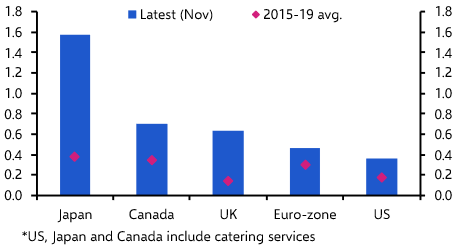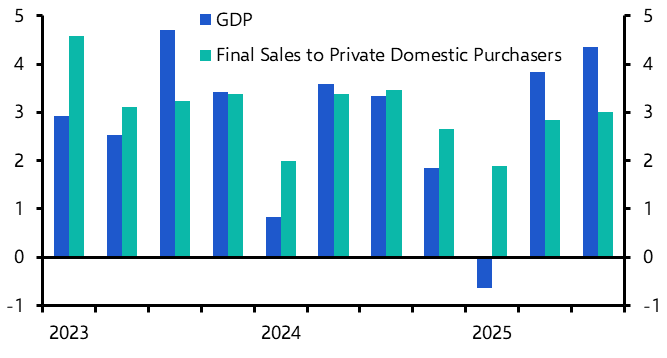Is Omicron inflationary? It’s one of the questions we’ve been asked most often since the identification of this new, and potentially more virulent, strain. Like much to do with Omicron, a lot remains uncertain and the full implications will not start to become clear until we know more about the threat posed and – crucially – the likely response from governments. Nonetheless, it is possible to sketch out a framework for thinking about the issue.
As ever in economics, the place to start is with demand and supply. It also helps to separate out the potential effect of Omicron on energy prices from the rest of the basket used to measure changes in the consumer prices of goods and services. This is because, while energy typically accounts for only 10-15% of CPI baskets, swings in prices tend to be large. As a result, they can have a significant effect on headline inflation.
A rebound in oil and gas prices means that energy has been responsible for around six-tenths of the rise in OECD inflation this year. But, as we’ve noted before, energy’s contribution should fall sharply in 2022, causing headline inflation in most economies to decline too. How might Omicron alter the picture?
If major new restrictions are reintroduced, then the market reaction after the news of Omicron first broke suggests that oil prices are likely to fall sharply. (Brent crude fell $10 to $72 per barrel during the Omicron-related sell-off on Friday, 26th November and has fallen by nearly 15% since mid-November.) While a major new wave, with associated restrictions on travel, would probably cause OPEC+ to delay the increases in output announced last week, and at the extreme could lead to renewed cuts in production, it is likely that this would be more than offset by any drop in demand for energy as travel is curbed.
Accordingly, in the event of a major new Omicron wave of the pandemic, energy’s contribution to inflation is likely to reverse more quickly than we currently anticipate. Chart 1 shows the contribution from fuel to OECD inflation next year under several scenarios for oil prices: our central forecast (which is for a gradual fall in Brent crude to $60pb by end-22), and alternative scenarios in which Brent falls to $60pb, $55pb and $45pb in the first quarter of 2022 and then stays there throughout rest of the year.
Chart 1: Fuel’s contribution to headline OECD inflation under different oil price scenarios

Sources: Refinitiv, Capital Economics
In these scenarios fuel shaves anywhere between 0.5%-pts and 1.0%-pts off headline inflation in advanced economies. This hit to energy prices means that the initial effect of a major Omicron wave is likely to be disinflationary rather than inflationary.
The effect on prices in other parts of the economy is less clear-cut. Supply is already failing to keep pace with demand in many countries, and would presumably be curtailed by further new restrictions. Two risks stand out. The first is that the spread of Omicron causes further disruption to global supply chains, for example due to factory shutdowns or port closures. The second is that a major new wave of the pandemic causes concerned workers to exit the labour market (or dissuades those that have already exited from returning). This is a particular concern in the US, where labour market participation has fallen sharply and labour shortages are especially acute.
Meanwhile, the implications for demand depend on the extent to which new restrictions are imposed, the degree to which those restrictions harm employment and incomes, the ability of households to draw down savings to replace any loss of income, and the extent of any policy support from governments and central banks.
In several countries, and particularly in the US, the extent of previous fiscal support means there is now less political backing for another round of measures, should they be required. However, set against this is the fact that private sector savings are now much higher than they were in previous waves of the pandemic. This gives households a pool of funds that they can draw upon to sustain spending in the event that they experience a significant hit to their incomes.
For all the current uncertainties surrounding Omicron, it is likely that if this new variant does trigger a major new wave of the pandemic then the initial effect would be disinflationary because energy prices would probably sink. But it’s possible that it could also exacerbate underlying price pressures – and thus medium-term inflation – if the hit to supply outweighs the hit to demand.
All of this will complicate the already-complex challenge facing policy makers. The threat of a new, more serious, variant of the virus may cause central banks to postpone plans to raise interest rates until the picture becomes clearer. This may mean that the Bank of England, for example, kicks its decision to tighten policy beyond next week’s MPC meeting and into next year.
But unless a new wave causes widespread and significant damage to economic activity, we doubt it will prevent most central banks from lifting interest rates in 2022.
In case you missed it:
- Our Senior Economic Advisor, Vicky Redwood, asks whether faster wage growth could spur productivity gains.
- Our Markets Economist, Thomas Matthews, asks if inflation is about to spell trouble for the stock market.
- Finally, a reminder that clients can view all of our research and analysis on the Omicron variant here, and can track the evolution of global supply shortages using our proprietary dashboard here.



